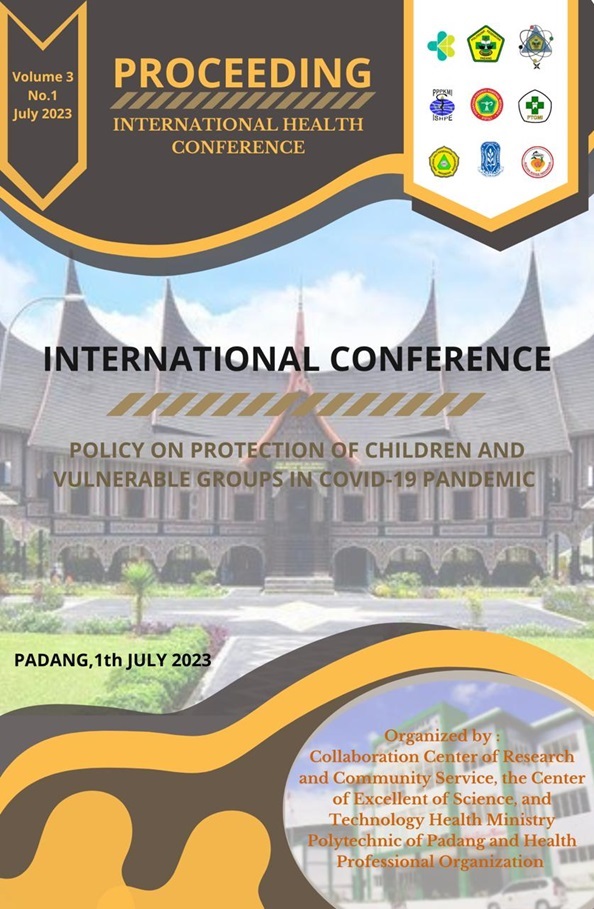Food Consumption and Safety Patterns of Stunted Children Aged 06-59 Months in the Working Area of Ophir and Sukamenanti Health Center of West Pasaman Regency in 2020
Abstract
Consumption patterns are not appropriate and food safety is a risk factor that is widely found and has a significant effect on the incidence of stunting in toddlers. Balita in food insecure households has a 2.62 times greater risk of suffering from stunting compared to food-safe households. The purpose of this study is to find out the Picture of Food Consumption and Safety Patterns in Stunted Toddlers Aged 06-59 Months in the Working Area of Ophir Health Center and Sukamenanti West Pasaman Regency in 2020. Research with cross-sectional study design was conducted in the working area of Ophir Health Center and Sukamenanti Health Center of West Pasaman Regency. The sample was a stunted toddler aged 06-59 months as many as 35 people taken by means of simple random sampling. The data collected are anthropometric data, dietary data (types and frequencies of basic foodstuffs) and food safety data with the Food Frequency Questionare (FFQ) method, conducted by researchers and 2 team members. The data obtained is analyzed descriptively. The results of this study describe the consumption patterns of children under five for basic food types 62.8%, animal protein 54.3%, vegetable protein 65.7%, vegetables 57.1%, fruits 54.3% unsalized with a staple food frequency of 85.7% and animal protein 68.6% good, vegetable protein 54.3% vegetables 51.4%, and fruit 97.1% is still lacking. Food safety risks unsafe judging from the types of snacks that are most commonly consumed is snacks (91.4%) with the amount of consumption of ≥6 types and frequency of consumption of snack foods as a whole category often (100%). The results showed that the consumption patterns of stunted toddlers in the working area of Puskesmas Ophir and Sukamenanti were less diverse in all types of foodstuffs and the frequency of vegetable, vegetable, and fruit protein was still lacking. Respondents often consume snacks and the most commonly consumed type is snacks. Dexpect respondents and families of respondents can pay more attention and regulate consumption patterns and pay attention to food safety from snack food respondents.
Downloads
References
Anugraheni, Hana Sofia, and Martha Irene Kartasurya. (2012). "Risk Factors for Stunting Events in Children Aged 12-36 Months in Pati District, Pati Regency" Journal of Nutrition College 1 (1): 30–37. https://doi.org/10.14710/jnc.v1i1.725.
Ardiansyah, Ardiansyah. (2016). "Know Well the Benefits of Food Additives" In Food Indonesia dreamed,edited by Santoso Umar, Winiati P. Rahayu, Rindit Pambayun, Giyatmi Giyatmi, Ardiansyah Ardiansyah, and Harmayani Harmayani. Indonesian Association of Food Technologists. http://repository.bakrie.ac.id/776/.
Baliwati, Yayuk Firda, Ali Khomsan, and C. MetiDwiriani. (2019). "Introduction to Food And Nutrition."
Damayanti, RA. (2016). "Differences in Nutritional Adequacy Levels and Exclusive Breastfeeding History In Stunting And Non-Stunting Toddlers." Indonesian Nutrition Media. https://e- journal.unair.ac.id/MGI/article/view/4393.
Hanum, Farida, Ali Khomsan, and Yayat Heryatno. (2014). "Relationship of Nutritional Intake and Maternal Height With Nutritional Status of Toddler Children." Journal of Nutrition and Food 9 (1). https://doi.org/10.25182/jgp.2014.9
Lestari, Wanda, Ani Margawati, and Zen Rahfiludin. (2014). "Risk Factors for Stunting in Children Aged 6-24 Months in Subulussalam City Dating District of Aceh Province." Jurnal Gizi Indonesia (The Indonesian Journal of Nutrition) 3 (1): 37–45. https://doi.org/10.14710/jgi.3.1.126-134.
Nuryani, Nuryani, and Rahmawati Rahmawati. (2018). "Snack Habits Related to The Nutritional Status of School Children In Gorontalo Regency." Indonesian Journal of Nutrition 6 (2): 114–22. https://doi.org/10.14710/jgi.6.2.114-122.
Rahmayana. (2014). "Mother's Parenting Relationship With Stunting Incident of Children Aged 24- 59 Months In Posyandu Asoka II Coastal Area of Barombong Village Tamalate District of Makassar City in 2014 | Rahmayana | Al-Sihah: The Public Health Science Journal." 2014, http://journal.uin-alauddin.ac.id/index.php/Al-Sihah/article/view/1965.
Syarifah NP. (2016). "The Influence of Knowledge, Attitudes and Family Support on Hypertensive Diet in Upstream Village of Pancur Batu District in 2016." Journal of Health. http://journal.uin- alauddin.ac.id/index.php/kesehatan/article/view/5107.










